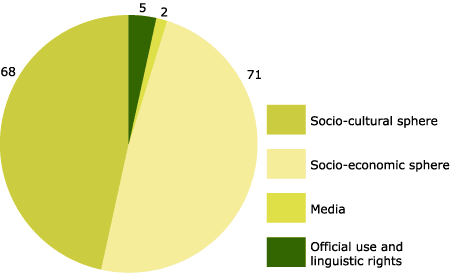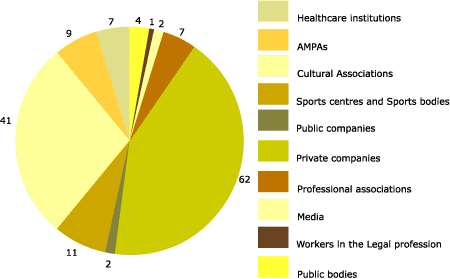
Summer 2003 |
| The Indexpla Applied to the City of Barcelona, by Montserrat Peitx | ||||
In this article we look at the application of Indexplŕ to 120 organisations in the city of Barcelona, involving more than 300 observations. The advantages offered by this instrument are evaluated, as a tool which can improve the image of our own organisation, and as an objective diagnostic tool. Also looked at is its usefulness when planning actions within language plans, following them up, and measuring results. Additionally, an analysis has been made of the behaviour of organisations in all the sectors of activity in which they concerned and according to the six factors evaluated by the instrument. In no case does it claim to be a study of language use in the city, but rather the practical results obtained by the instrument. (1)
|
|||
Summary 2. The growth in the use of Catalan 3. The Practical Results of applying the Indexpla 5. Analysis of the first observations by sector 6. Analysis of the first observations by sub sector 7. First and last observations of all sectors 10. Analysis of the first observations of the factors 1. Introduction The Indexpla is a tool which allows the level of linguistic normalisation of an organisation to be measured objectively at a given moment, and also allows the evolution of this normalisation to be measured over specific periods of time showing the results of any actions that have been taken to increase the level of Catalan usage. For each organisation observed, an index of linguistic normalisation (ILN) is obtained. This index is calculated from data obtained from the study of six factors (image and communications, linguistic competency of staff, linguistic usage criteria, external documentation, external communications, and internal documentation and communications). The Language Normalisation Centre cpnl.org (CNL) in Barcelona has made more than 300 Indexpla observations at more than 120 organisations throughout the city. The results have made possible an evaluation which goes beyond the linguistic evolution of each organisation. Furthermore, some overall conclusions have also been extracted which apply to the sectors or factors included in the study. These conclusions, however, cannot be extrapolated to the linguistic usage of all of the organisations throughout the city, nor will they indicate the level of the presence of Catalan in the city. This information – the oral and written linguistic permeation of Catalan in public institutions, private organisations and throughout society in general – can be obtained by applying the Ofercat system, which was inspired by the Indexpla. A pilot trial of Ofercat has been carried out in the Ciutat Vella district of Barcelona. 2. The growth in the use of Catalan One of the main objectives of the CNL in Barcelona is to encourage the use of the Catalan language in all areas throughout the city, especially within the socio-economic and socio-cultural sectors. In 1995, a new, experimental technique was implemented – linguistic management. This was one of the services provided by the CPNL (the Consortium for Language Normalisation) in order to plan linguistic usage in such a way so as to incorporate and increase the use of Catalan in communications. It was important, if not essential, to have an objective and graphical method of diagnosis, and also a way in which to evaluate the process of the growth in the knowledge and use of Catalan in those organisations that the CPNL was working with – the Indexpla. 3. The Practical Results of applying the Indexpla Over the years we have been able to observe how applying the Indexpla has produced a series of practical consequences that we can evaluate from various angles: - an improvement in our image, an objective diagnostic tool, a change in the way objectives were planned, and also a change in the follow-up and evaluation of the objectives of normalisation plans, and finally, a way of grouping organisations according to the ILN. 3.1. The Indexpla and the improvement in our image Presenting this linguistic analysis to client organisations has added an innovative element to our image, which has proved to be of significant technical value when we have to communicate with such organisations. Before the Indexpla was applied, negotiations with organisations were poorly structured and it was often difficult to present our services in an objective way. Now, using the Indexpla, we can demonstrate the information we obtain regarding the linguistic situation observed in an organisation, in a simple, systematic way. 3.2. The Indexpla as a diagnostic tool When an organisation allows us to produce an objective diagnosis using observations from multiple indicators, they are in effect opening the doors to a complete linguistic audit comprising personal interviews, observations, access to documentation etc. Before we worked with Indexpla, access to such information was often a problem – organisations were wary about providing certain data because they did not know what use might be made of it. Now, with the Indexpla, they know exactly why we want the information and that has made our relationship with the organisation much more straightforward. 3.3. The Indexpla and Planning Whenever we have begun to work with an organisation we have produced an initial linguistic plan for them, but after the Indexpla is applied, the design of these plans changes, and new objectives, closely linked to the above-mentioned Indexpla factors, are then formulated. The plan can then be designed depending on the results of the initial diagnosis. A detailed analysis, employing and adapting to these factors, assists in defining the actions and achieving the objectives set out in the subsequently produced linguistic plan. 3.4. The Indexpla and follow-up and evaluation of plans The Indexpla, from the initial diagnosis onwards, allows for successive analyses to be made (these are normally done on a yearly basis throughout the period when we are working with the organisation in question). These analyses are useful for any adjustments that need to be made to the agreements laid down in the original plan, re-channelling the measures established to improve results, and to evaluate what has actually been achieved when the collaboration has been completed. The Indexpla allows for summary sheets to be drawn up where any temporary measures results obtained are described, as well as those obtained whilst working with us. These summary sheets are useful when deciding whether to continue with or call a halt to a programme, because they allow us to see whether the process is advancing satisfactorily or whether it has stagnated. If the ILN is low or very low, certain measures must be taken in order to guarantee the process of increasing the use of Catalan. This is achieved by extending the type of communication situations when Catalan is used. Our task here is to focus more on awareness-raising and the diffusion of the language, and not on achieving linguistic change. If the organisations have a medium to high ILN, the objectives should focus on the consolidation of the process of linguistic normalisation, and on the growth of the level of linguistic autonomy. 3.5. The Indexpla allows organisations to be classified according to their ILN. When the process is initiated, a linguistic analysis of the communications of the organisation and the linguistic aptitude of its staff is undertaken. This analysis is done by applying the Indexpla, which classifies organisations by their level of normalisation according to the ILN. This index has a value of between 0 and 100: - if the index is above 80%, then the organisation is considered to have achieved a high level in the use of Catalan; if it is between 60% and 80% then it has reached the normalisation threshold; an index below this level would indicate that the organisation is not able to attend to the public or communicate in Catalan. The Indexpla has been tried in Barcelona in the ‘Official use and linguistic rights’, the ‘Socio-economic sphere’, and the ‘Health and social institutions’ sectors. It has been applied to more than 120 organisations over the last five years. This is a significant number of organisations, which means that we have been able to gauge the usefulness of the Index, and it has also allowed us to study the perceived changes in a more objective way. It cannot, however, be used to make extrapolations for all sectors, but it can detect the increase or decrease of activity in each sector. In the ‘Education, research and youth’ and also in the ‘Media and cultural industries’ sectors, work has been of a sporadic nature, thus the data obtained was not considered to be of significance. Figure 1. Number of organizations by sectors
Figure 2. Distribution of organizations by sub sectors
5. Analysis of the first observations by sector We compiled all of the first observations made over the period of the study. The organisations with which a collaboration agreement had only recently been agreed had only undergone this first observation. |

